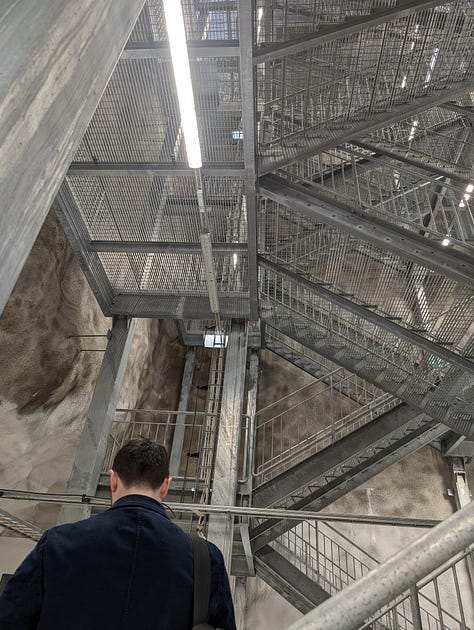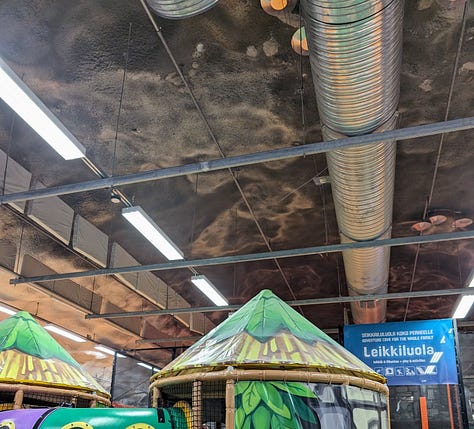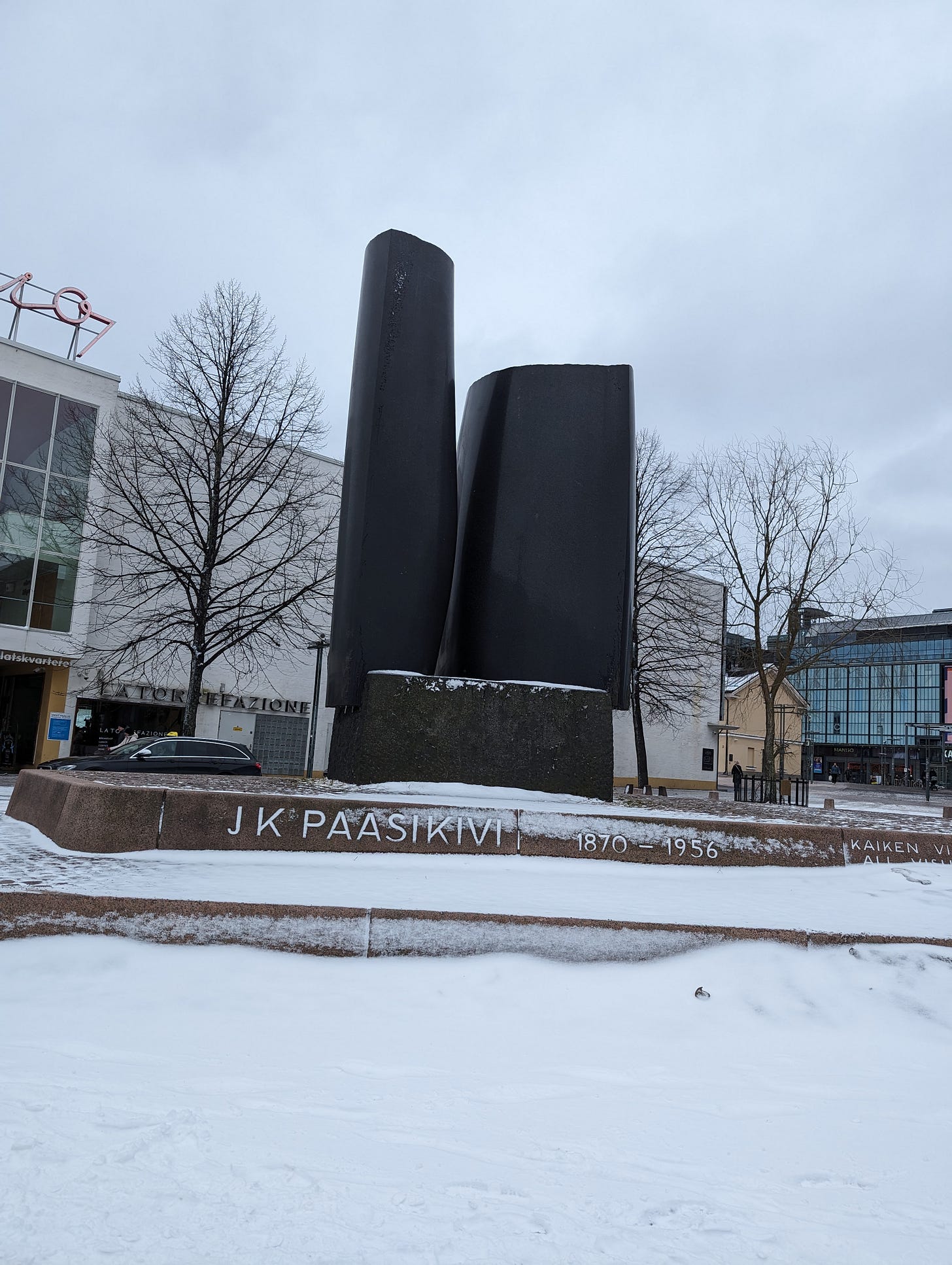One of the best playgrounds for children in Helsinki is the size of three NFL football fields, dug into bedrock 25 metres below a street-level car park, and built to survive a nuclear bomb.
The air down here is surprisingly fresh. The floor-hockey rinks — there are two, laid end to end — are well maintained. The refreshment stands are stocked with snacks. The steel blast doors are so massive it takes two people to slam one shut.



Finland has been building civil-defence shelters, methodically and without fuss, since the late 1950s. This one under the Merihaka residential district has room for 6,000 people. It’s so impressive that it’s the Finnish capital’s unofficial media shelter, the one visiting reporters are likeliest to be shown. The snack bar and the jungle gym are not for show, however: as a matter of government policy, every shelter must have a second, ordinary-world vocation, to ensure it gets used and, therefore, maintained between crises.
The Merihaka shelter was one of the stops on my visit to Helsinki last week. The first anniversary of Finland’s membership in NATO, the transatlantic defence alliance, is next week, on April 4. Finland’s foreign office invited journalists from several NATO countries to visit Helsinki to update us on Finland’s defence situation. I covered my air travel and hotel. Or rather, paid subscribers to this newsletter did. Your support makes this sort of work possible. I’m always grateful.
The Finnish government used to build most of the shelters. But since 2011, the law has required that new shelters be built at the owners’ expense, by owners of buildings larger than 1,200 square metres and industrial buildings larger than 1,500 square metres.
The city of Helsinki has more shelter space than it has people, including visitors from out of town. Across the country the supply is a little tighter. Altogether today Finland has a total of 50,500 shelters with room for 4.8 million people.
That’s not enough for the 5.5 million people in Finland. But then, if war ever comes, much of the population won’t need shelter, because they’ll be staying groundside to fight.
Conscription is universal for Finnish men between 18 and 60. (Women have been enlisting on a voluntary basis since the 1990s.) The standing armed forces, 24,000, aren’t all that big. But everyone who finishes their compulsory service is in the reserves for decades after, with frequent training to keep up their readiness. In a war the army can surge to 280,000. In a big war, bigger still.
The Soviet Union invaded Finland in 1939, during what was, in most other respects, the “phony war” phase of the Second World War. The Finnish army inflicted perhaps five times as many casualties on the Soviets as they suffered, but the country lost 9% of its territory and has no interest in losing more. Finland’s foreign policy since then has been based on the overriding importance of avoiding a Russian invasion.
Sometimes this has involved sticks, sometimes carrots. In Helsinki I noticed a monument to the postwar Finnish president J.K. Paasikivi. (It was one of the city’s first abstract monuments to a real person. Local wags used to say it depicted Paasikivi and his wife.)
Paasikivi and his successor Urho Kekkonen, who between them governed from 1946 to 1982, advocated for the closest possible relations with the Soviets — to the point of censoring school curricula and pop-culture products that too overtly criticized Moscow, like John Frankenheimer’s fantastic film The Manchurian Candidate.
Later generations of Finns mostly reject the Paasikivi-Kekkonen doctrine. But chillier relations with the bear bring their own risk. The Russo-Finnish border is 1,340 km long. Finns’ assumption has long been that if an invasion ever came, Finland would have to defend itself.
“Neutrality never was an ideological choice for Finland in the same way it has been for the likes of Sweden, Austria or Switzerland,” Elina Valtonen, Finland’s foreign minister, told my group of visitors. “When Finland was neutral, it was more of a pragmatic choice rather than based on strong ideological views.” In fact Finland has been more and more integrated into the Western orbit: it joined the European Union in 1995 and was a “strategic partner” with NATO since 1995. “On the day we joined the Alliance, our military was almost 100% interoperable with NATO,” Valtonen said.
But the final step, full NATO membership, was one Finland long resisted, even after Vladimir Putin invaded Crimea in 2014. When the full invasion of Ukraine came in 2022, opinion flipped rapidly and — in the opinions of the experts I met last week — irrevocably. “Absolutely everything has changed,” one senior foreign-ministry official said. “There’s no turning back to the relationship that we had with Russia before.”
So now the job is to define the new relationship — both with Russia, and with Finland’s new NATO allies. A new defence policy is due later this year, but the basic idea is that Finland will work most closely with its Scandinavian neighbours: Norway, which has been with NATO since its founding in 1949, and Sweden, which also changed its mind about NATO in 2022 but whose accession was delayed until earlier this month. They’re basically three fingers running north to south:
Norway has a fierce navy, Sweden a big air force, and Finland an army few countries its size could field. Each expects to focus on its strength. So it’s less likely that they’ll contribute significant troops to NATO’s enhanced forward presence in the Baltics and Poland, including the Canadian-led battle group in Latvia, than that they’ll project NATO’s territory and capability further north and east, without imposing a particular burden on the rest of NATO.
How do Finns feel about all this? As it happens, the government polls on this. Obsessively. It has for decades. Finland’s governments have long viewed the willingness of the citizenry to fight as part of the defence apparatus. The latest round of polling shows that nine out of 10 have a positive view of NATO membership; 97% agree that “other NATO countries must be prepared to defend Finland” in the event of an attack (84% agree “fully”); 91% agree that “Finland must be prepared to defend another NATO country” in the event of armed aggression. If Finland were attacked, 79% agree that “Finns… [should] take up arms to defend themselves in all situations, even if the outcome seemed uncertain.” What about each respondent, personally? That’s a question too: 83% said they would be willing to participate in national defence. This includes 74% of supporters of the Left Alliance, the most left-leaning party in the country’s Parliament.
Together these poll results, which the government has been collecting for decades, were mentioned by civil servants, think tankers and Finnish journalists at just about all of our meetings, as if referring to the amount of fuel in a gas tank. Eventually I thought: This is Sparta. And indeed, visiting journalists have sometimes tried to hang the name “Sparta of the North” onto Finland. After giving the analogy some thought, I eventually decided it’s a lousy fit. The country has a functioning social democracy with high membership in trade unions. Helsinki has spent the last two decades turning an old rail yard near the centre of town into an extraordinary cultural campus with a concert hall, modern-art museum, convention centre and public library. More impressive in person than in my photo:
In short, Finns seem pretty good at compartmentalizing a modern cosmopolitanism that would be familiar to residents of any other Western democracy next to a steely-eyed determination to do what it takes to protect what they’ve built.
What do they make of their new allies? Feelings are not unanimous. As NATO membership approached, the number of army reservists who took advantage of a longstanding right to resign from military service to civilian jobs skyrocketed. It has stayed high by historic standards — about 10 times the usual rate, though still a small fraction of total reserves.
What struck me was that the government interviewed reservists as they switched jobs. Some had essentially pacifist motives — “ethical reflections on war and killing,” apparently more acute now that war and killing feel closer — but others were harsher in their view of Finland’s new allies. “Any alliance with the USA is a bad thing,” some said. “The NATO membership was a plot by political elite and mainstream media,” others said. How many? How prevalent were these views? My briefers didn’t know the answer.
Finland’s defence minister, Antti Häkkänen, has considered new legislation outlawing resignation from the military reserves since resignations spiked. I don’t know enough about Finnish law to judge his chances, though I doubt it’s a slam dunk. Like governments in general that are close to Russia, Häkkänen worries that the West’s aid to Ukraine isn’t sufficient. “Of course, Russia is in a wartime footing in their own industry and economy,” he told us. “We are in peacetime in the West. That's the main challenge, the political challenge. We just have to run a little bit faster.”
Fast enough to join Emmanuel Macron, who has been stubbornly musing about the possibility of NATO troops in Ukraine? The notion seems to puzzle the Finns I spoke to just as much as it does Macron’s colleagues further south. “Ground troops? Never,” one think-tanker told us. (Almost everyone except the two cabinet ministers spoke on the understanding their remarks wouldn’t be attributed. Sorry about that.) Then he amended himself: “Highly, highly unlikely.”
Valtonen, the foreign minister, essentially debated herself when asked about Macron’s remarks. “Our position is clear. Right now, we are not considering sending boots on the ground,” she said. “And we're not even willing to discuss that at the moment.”
Clear enough? “But for the long term, I don't think anything should be ruled out… We live in a changing world, and you never know what happens. So nothing should be ruled out for forever. But right now, we are ruling it out quite clearly. And also, I don't think it's a problem at all that President Macron raised the idea. No, we actually applaud it, because it just shows that there's growing concern over what's happening in Ukraine.”
To be continued, I guess. The next summit of NATO heads of government will be in Washington, DC in July — days before the Republicans hold the first of the year’s two presidential nominating conventions. It’s hard to imagine a higher-stakes gathering of the newly enlarged alliance’s leaders.








Very timely piece. And Canadians should take note. We need to shore up our own northern and other defences… with some ‘steely determination’ of our own. The world is changing.
Excellent piece Paul! And, timely as was said above. In an earlier time in my career I was involved in arctic shipping and Finland was the global leader in ice breaking research and development. Amazing those Finns!! I’m so pleased you are able and willing to do things like this trip!!